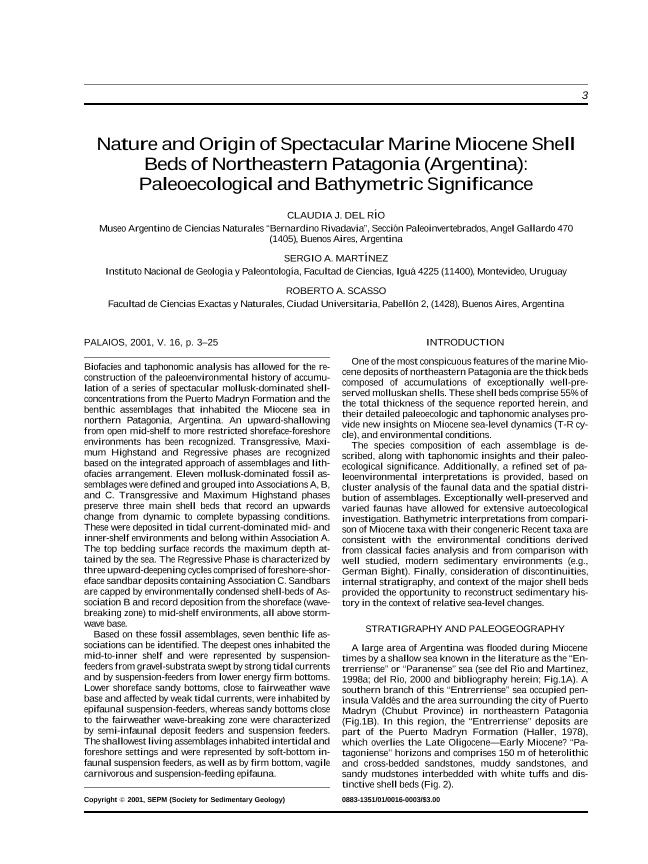Artículo
Nature and Origin of Spectacular Marine Miocene Shell Beds of Northeastern Patagonia (Argentina): Paleoecological and Bathymetric Significance
Fecha de publicación:
02/2001
Editorial:
Society for Sedimentary Geology
Revista:
Palaios
ISSN:
0883-1351
Idioma:
Inglés
Tipo de recurso:
Artículo publicado
Clasificación temática:
Resumen
Biofacies and taphonomic analysis has allowed for the reconstruction of the paleoenvironmental history of accumulation of a series of spectacular mollusk-dominated shell-concentrations from the Puerto Madryn Formation and the benthic assemblages that inhabited the Miocene sea in northern Patagonia, Argentina. An upward-shallowing from open mid-shelf to more restricted shoreface-foreshore environments has been recognized. Transgressive, Maximum Highstand and Regressive phases are recognized based on the integrated approach of assemblages and lithofacies arrangement. Eleven mollusk-dominated fossil assemblages were defined and grouped into Associations A, B, and C. Transgressive and Maximum Highstand phases preserve three main shell beds that record an upwards change from dynamic to complete bypassing conditions. These were deposited in tidal current-dominated mid- and inner-shelf environments and belong within Association A. The top bedding surface records the maximum depth attained by the sea. The Regressive Phase is characterized by three upward-deepening cycles comprised of foreshore-shoreface sandbar deposits containing Association C. Sandbars are capped by environmentally condensed shell-beds of Association B and record deposition from the shoreface (wave-breaking zone) to mid-shelf environments, all above storm-wave base. Based on these fossil assemblages, seven benthic life associations can be identified. The deepest ones inhabited the mid-to-inner shelf and were represented by suspension-feeders from gravel-substrata swept by strong tidal currents and by suspension-feeders from lower energy firm bottoms. Lower shoreface sandy bottoms, close to fairweather wave base and affected by weak tidal currents, were inhabited by epifaunal suspension-feeders, whereas sandy bottoms close to the fairweather wave-breaking zone were characterized by semi-infaunal deposit feeders and suspension feeders. The shallowest living assemblages inhabited intertidal and foreshore settings and were represented by soft-bottom infaunal suspension feeders, as well as by firm bottom, vagile carnivorous and suspension-feeding epifauna.
Palabras clave:
MIOCENE
,
PATAGONIA
,
ARGENTINA
,
SHELL BEDS
Archivos asociados
Licencia
Identificadores
Colecciones
Articulos(MACNBR)
Articulos de MUSEO ARG.DE CS.NAT "BERNARDINO RIVADAVIA"
Articulos de MUSEO ARG.DE CS.NAT "BERNARDINO RIVADAVIA"
Citación
del Río, Claudia Julia; Martinez, Sergio A.; Scasso, Roberto Adrian; Nature and Origin of Spectacular Marine Miocene Shell Beds of Northeastern Patagonia (Argentina): Paleoecological and Bathymetric Significance; Society for Sedimentary Geology; Palaios; 16; 1; 2-2001; 3-25
Compartir
Altmétricas




